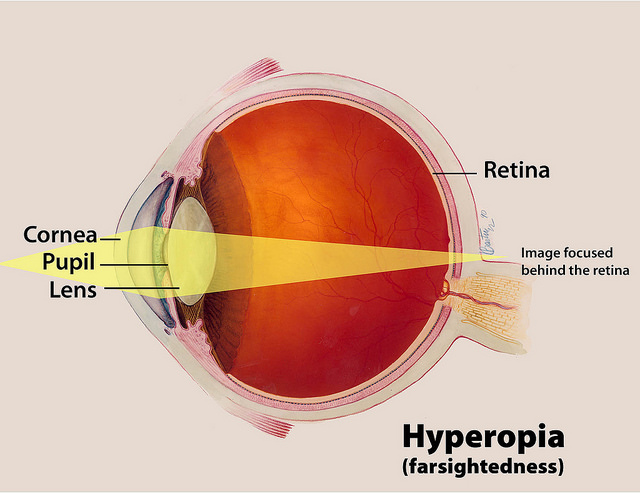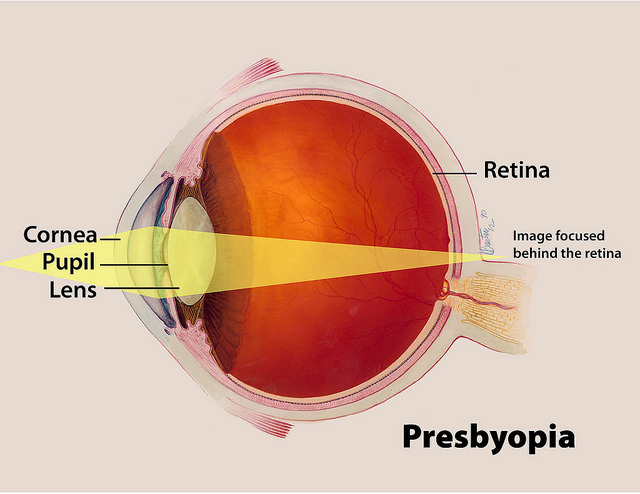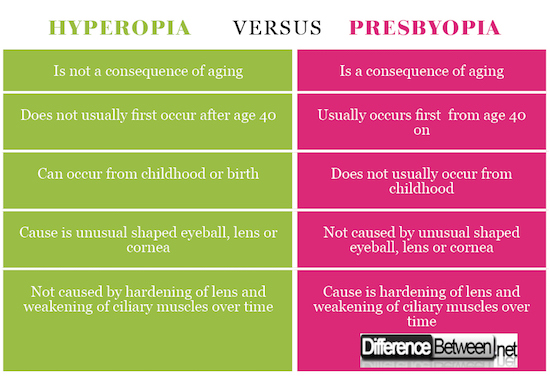Difference between Hyperopia and Presbyopia
What is Hyperopia?

Hyperopia is a vision condition in which objects that are further away can be brought into focus and seen clearly but objects that are nearby or close to you cannot be seen clearly and thus appear unfocused.
The eye works by the process of refraction in which the incoming light is bent by the cornea and lens and is directed onto the region at the back of the eye, the retina, where the signal excites special cells that transmit the signal to the brain where the image is interpreted.
Hyperopia is a refractive error since the light is not reaching the proper part of the retina but is instead focusing at a point beyond the retina.
If the eyeball is too short then hyperopia can occur, or if the lens or cornea has the wrong shape. It can also occur if the muscles that hold the lens in place are weak. These muscles that hold the lens in place are known as the ciliary muscles.
Hyperopia can occur at any age, but is common in children and can occur right from birth. You are more likely to have this condition if you have a family history or have diabetes. In some cases medication can also cause this problem. An eye exam will determine if you have hyperopia.
Contact lenses, glasses or refractive surgery can correct the condition. One way to know if you have hyperopia is if your lens prescription begins with a “+”, for example +1.50.
The surgery called Laser assisted in situ keratomileusis (LASIK) has become quite popular in treating the condition. There are other surgeries such as Photorefractive keratectomy (PRK) which like LASIK can change the shape of the cornea to better focus the light.
What is Presbyopia?

Presbyopia is a vision condition in which objects that are further away can be seen clearly and are in focus, but objects that are close to you can’t be seen clearly and are out of focus. This condition is also known as a refractive problem, with light not being focused properly on the retina.
As a person ages their eyeball often does change shape. The lens in particular becomes harder with age, with the result that they can end up having presbyopia and needing to wear glasses or contact lenses to correct it.
This often happens after the age of 40. With aging the lens is less able to change shape and adjust so you can see close up. This is because there is less of a particular protein called α-crystallin, which is important in the process.
Symptoms include blurry vision when trying to read a book for instance, eyestrain, and headaches. Often you can see better by holding the book further away from you. Symptoms are worse in conditions of low light.
An eye exam will be able to diagnose and confirm that you have presbyopia. This needs to be done fairly often as the condition is likely to worsen until you reach 65 years of age. Depending on your age when you are diagnosed you will need an eye exam every 1 to 3 years.
Contact lenses, glasses or refractive surgery can correct the condition. In the past people would buy reading glasses which did not require a prescription.
Today you can also buy glasses with multifocal lenses so that other problems you may have will be corrected. For example if you also have hyperopia or myopia in addition to presbyopia. That way you won’t need to have both reading glasses and separate glasses for your other eye condition.
Laser surgery can be performed to correct the problem. Patients can also have corneal implants placed in the affected eye.
What is the difference between Hyperopia and Presbyopia?
- Hyperopia is not a consequence of aging while presbyopia is.
- Presbyopia usually occurs first from age 40 on, while this is not the case for hyperopia.
- Hyperopia often occurs from childhood or birth, this is not the case with presbyopia
- Hyperopia is caused by an unusual shaped eyeball, lens or cornea, this is not usually the cause for presbyopia
- Presbyopia is caused by a hardening of the lens and weakening of ciliary muscles over time, this is not usually the case for hyperopia
Table comparing Hyperopia and Presbyopia

Summary
- Hyperopia and presbyopia are both vision conditions in which you can clearly focus on objects close to you, but can’t see objects that are far away from you.
- In both cases the light that passes through the eye focuses on a point beyond the retina instead of on the retina.
- Both hyperopia and presbyopia are vision conditions where there is an error of refraction with the light not reaching the correct part of the retina.
- Hyperopia is a condition that you can have from birth or get as a child while presbyopia is a condition that is a consequence of becoming older.
- Presbyopia commonly starts at or after about age 40 and is because the lens of the eye cannot adjust as easily. The lens hardens as you age and the muscles holding the lens in place also weaken.
- Hyperopia is caused by an unusual shaped eyeball, cornea or lens.
- Both hyperopia and presbyopia can be corrected by wearing glasses with lenses to correct the focusing of the light. Contact lenses can be used instead of glasses.
- Various surgical options are available for treating both hyperopia and presbyopia or you can simply wear glasses or contact lenses to correct the problem.
- Difference Between Rumination and Regurgitation - June 13, 2024
- Difference Between Pyelectasis and Hydronephrosis - June 4, 2024
- Difference Between Cellulitis and Erysipelas - June 1, 2024
Search DifferenceBetween.net :
2 Comments
Leave a Response
References :
[0]National Eye Institute. “Hyperopia”. National Eye Institute. National Eye Institute, 2018, https://nei.nih.gov/health/errors/hyperopia
[1]National Eye Institute. “Hyperopia”. National Eye Institute. National Eye Institute, 2018, https://nei.nih.gov/health/errors/hyperopia
[2]Mayo Clinic. “Presbyopia.” Mayo Clinic. Mayo Clinic, 1998-2018, https://www.mayoclinic.org/diseases-conditions/presbyopia/symptoms-causes/syc-20363328
[3]All About Vision. “Hyperopia.” All About Vision, All About Vision, 2000-2018, http://www.allaboutvision.com/conditions/hyperopia.htm
[4]Image credit: https://www.flickr.com/photos/nationaleyeinstitute/20072195059
[5]Image credit: https://www.flickr.com/photos/nationaleyeinstitute/20258792625

In your summary you are actually describing MYOPIA (clear close up vision & blurry distance vision). I think you got the two mixed up? And meant to say, for hyperopia & presbyopia, “CAN’T clearly focus on objects close to you”, “but CAN see objects that are far away from you”?
Instead you wrote:
“Summary”
“Hyperopia and presbyopia are both vision conditions in which you can clearly focus on objects close to you, but can’t see objects that are far away from you.”
Hi, Dr. Rae
Thank you for your information, but I think there is a little mistake in your summary chapter.
Because is saying that ”Hyperopia and presbyopia are both vision conditions in which you can clearly focus on objects close to you, but can’t see objects that are far away from you.”
It should be like this: ‘Hyperopia and presbyopia are both vision conditions in which you can clearly focus on objects that are far from you, but can’t see objects that are close to you.’
Have a nice day,
Sincerely